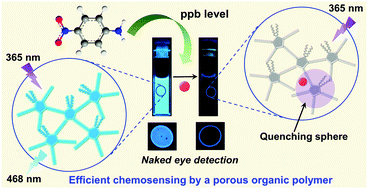Trace level detection of nitroanilines using a solution processable fluorescent porous organic polymer†
Abstract
A solution processable conjugated porous organic polymer (POP) based on tetraphenyl-5,5-dioctylcyclopentadiene (TPDC-DB) was employed for nitroaromatic sensing by amplified fluorescence quenching. A comprehensive investigation was carried out using a set of 30 closely related analytes such as nitrophenols, nitrotoluenes, nitroanilines, nitobenzenes, and quinones. Nitroanilines were found to be the most efficient quenchers in contrast to the extensively studied picric acid, which is unprecedented among POPs. Rigorous spectroscopic investigations including UV-Vis absorption, steady-state and time-resolved fluorescence, and electron paramagnetic resonance coupled with computational studies provided new insights into the underlying photophysical phenomenon of fluorescence quenching. Stern–Volmer plots were analyzed employing the sphere of action model. It was observed that the electron-deficient nature of the nitroaromatics is not the sole governing factor responsible for fluorescence quenching. Naked eye detection of nitroanilines by TPDC-DB was also demonstrated. Detection limits for p-nitroaniline were found to be extremely low, 455 ppb in solution and ∼1.8 ng cm−2 in contact mode.


 Please wait while we load your content...
Please wait while we load your content...